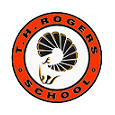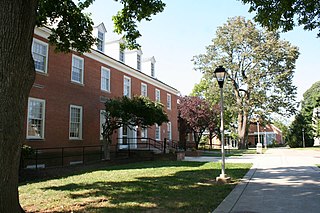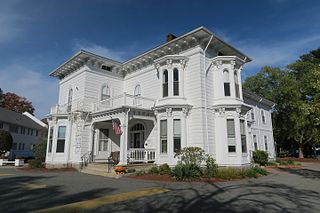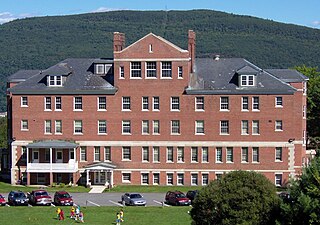NextSense, formerly the Royal Institute for Deaf & Blind Children, in Sydney provides a range of educational services for students with vision and/or hearing impairment, including specialist schools for signing Deaf students, oral deaf students, and students with sensory and intellectual disabilities.

Thomas Horace Rogers School is an alternative primary and secondary public school and part of the Houston Independent School District. The school is at 5840 San Felipe in Houston, Texas, United States, outside of the 610 Loop and inside Beltway 8, west of Uptown Houston.

The Maryland School for the Deaf (MSD) offers public education at no cost to deaf and hard-of-hearing Maryland residents between the ages of zero and 21. It has two campuses located in Frederick and Columbia, Maryland.
The Berkeley Heights Public Schools are a comprehensive community public school district serving students in pre-Kindergarten through twelfth grade from Berkeley Heights in Union County, New Jersey.

The Learning Center for the Deaf (TLC) is a Framingham, Massachusetts-based non-profit organization and school serving deaf and hard-of-hearing children and adults.

Indiana School for the Deaf (ISD) is a fully accredited school for the deaf and hard of hearing, located in Indianapolis, Indiana.
The South Dakota Services for the Deaf (SDSD) is a state agency that supports deaf children in South Dakota. Formerly it was a state-supported school located in Sioux Falls, South Dakota that provided services to meet the educational needs of children who are deaf, hard-of-hearing, or have cochlear implants. SDSD is governed by the South Dakota Board of Regents.

Rochester School for the Deaf (RSD) is a private, tuition-free school for deaf and hard of hearing students to attend in Rochester, New York. It is one of the oldest and most respected preK-12th grade schools for children with hearing loss and their families in the United States, and one of nine such school in the state of New York. Serving the Central and Western portions of New York State, it has been educating students since 1876.

The Atlanta Speech School is a language and literacy school located in Atlanta, Georgia, established in 1938. The school provides educational and clinical programs. The Atlanta Speech School's Rollins Center provides professional development for teachers and educators in partner schools and preschools. The Rollins Center focuses on the eradication of illiteracy. The Rollins Center has an online presence called Cox Campus, which is an online learning environment with coursework targeted for the education of children age 0–8.

The Minnesota State Academy for the Deaf (MSAD) is a public residential school serving deaf children in Minnesota, United States. It is one of two Minnesota State Academies in Faribault and operated by the state for particular student populations.
The Tennessee Schools for the Deaf (TSD) is a state-operated residential and day school for deaf and hard-of-hearing students who reside in the state of Tennessee ranging from pre-kindergarten to grade 12 also includes a post-secondary transition/occupational program. It is located in Knoxville, Tennessee within the historic Island Home Park neighborhood.

The Nebraska School for the Deaf, or NSD, was a residential school for Deaf students in kindergarten through Grade Twelve at 3223 North 45th Street in Omaha, Nebraska, United States. Founded in 1869, the school closed in 1998. The school attracted national attention throughout its existence, first for controversial teaching practices and then for its closure.
The Vermont Center for the Deaf and Hard of Hearing, a non-profit organization, was the primary educational and support services resource for Deaf and Hard of Hearing residents in Vermont and surrounding areas. The Vermont Center, headquartered at Brattleboro’s Austin’s School For The Deaf, was launched by the Austine School in 1998 and operated until 2014. The Austine School was one of four independent schools and twelve outreach programs through which the Vermont Center assisted thousands of Vermonters who had hearing loss.

The Austine School for the Deaf, now closed, in Brattleboro, Vermont, was an independent, coeducational day and residential school for deaf and hard-of-hearing children age four to eighteen from New England and New York.
The Metropolitan Toronto School for the Deaf is a division of the public school, Davisville Junior Public School / Metropolitan Toronto School for the Deaf, in Toronto, Ontario with day programs serving deaf and hard-of-hearing students from kindergarten to grade eight. In this division, American Sign Language and Spoken English with the aid of Signed Exact English are used as the languages of communication.

Founded in 1850, the Arkansas School for the Deaf (ASD) is a state-run public school in Little Rock, Arkansas, United States, serving deaf and hard of hearing students through residential, day school, and part-time enrollment programs. The school offers preschool through high school, and is affiliated with the Arkansas Association of the Deaf (AAD) and the National Association of the Deaf (NAD).
The Governor Baxter School for the Deaf (GBSD), formerly known as the Maine School for the Deaf is a public co-educational school that serves the deaf and hard-of-hearing in the State of Maine. It is located on Mackworth Island, an approximately 100-acre (40 ha) island in Falmouth, Maine, USA, adjacent to its border with Portland, Maine. Students who live far away may stay with host families, who provide residential services. Its program is the Maine Educational Center for the Deaf and Hard of Hearing (MECDHH).
The Tucker Maxon School is an educational institution based in Portland, Multnomah County, Oregon, United States, which assists children who are deaf or hard of hearing, as well as children with typical hearing, in a co-enrolled classroom environment. Tucker Maxon is a 501c(3) non-profit corporation governed by a 14-member Board of Directors and managed by a 30+ member staff and faculty.
Kendall Demonstration Elementary School (KDES) is a private day school serving deaf and hard of hearing students from birth through grade 8 on the campus of Gallaudet University in the Trinidad neighborhood of Washington, D.C. Alongside Model Secondary School for the Deaf, it is a federally funded, tuition-free demonstration school administered by the Laurent Clerc National Deaf Education Center at Gallaudet University.
Dr. Laurene Simms is a Deaf American educator and advocate. She is the Chief Bilingual Officer at Gallaudet University.











